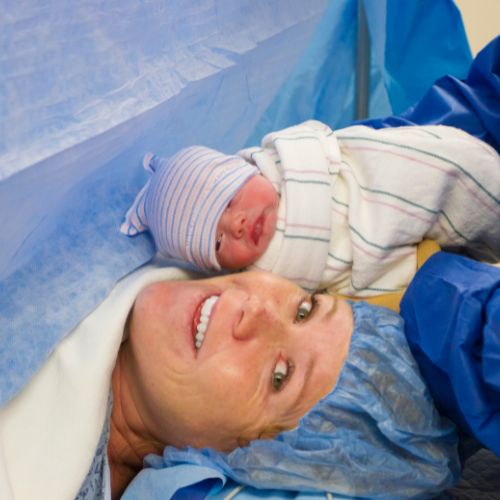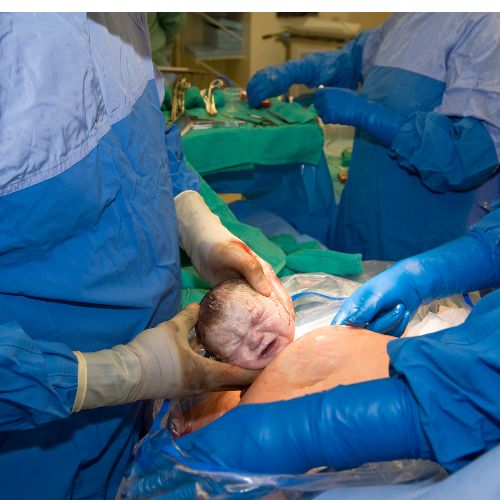In the United States, 31.8% of births are via cesarean section. First introduced around 2008, the idea of a “natural c-section” has been growing in popularity.
Also called a “gentle c-section” or a “family-centered c-section”, there are just a few things different than a traditional c-section. The idea is to mimic certain aspects of a vaginal birth that are often left out when someone has a cesarean birth.
Some people find it devastating to hear that a cesarean is being recommended, especially those that desire a more natural childbirth. Having a “natural” or “gentle” c-section is a way to bridge the gap between vaginal and cesarean birth.

What is a natural c-section
The names “gentle” or “natural” cesarean are a bit misleading since the surgery itself is the same. Whether you desire a more traditional cesarean or a natural cesarean, the delivery is major surgery to the abdomen, requires a uterine incision, and birth in an operating room. However, a “gentle” or “natural” c-section looks to involve the family more in the birth of their baby despite it being a surgical procedure.
First described in 2008 in a paper entitled “The natural caesarean: a woman-centred technique”, the idea of a natural cesarean is to improve satisfaction with birth, increase breastfeeding rates, and create a more natural delivery for cesareans. You can read the entire article for free here.
What happens in a c-section
A c-section is the surgical delivery of a baby. All cesarean births are done in an operating room by a surgeon. This surgeon is typically the patient’s obstetrician. An abdominal incision is made along the bikini line followed by a horizontal uterine incision. The amniotic sac is broken and the baby is then taken out through that incision. The surgeon will then hand the baby to another member of the care team and will remove the placenta. The incisions are then sutured closed and a dressing or steri strips may be applied. After the incisions are closed, you will move to the recovery room for a few more hours of monitoring.
You may be given an abdominal binder during your recovery to help with pain and healing. Vaginal bleeding after a cesarean is also to be expected for the first few weeks.
A c-section usually takes 60-90 minutes total, including the time it takes to get a spinal block by an anesthesiologist and the time it takes to sew everything back together. Once the procedure starts, baby is born within 10-20 minutes. The number of c-sections a person has had can affect the amount of time it takes since there is usually more scar tissue to cut through.
Having one c-section delivery does not mean you will have to with future pregnancies. Many people have gone on to have vaginal deliveries after having a cesarean birth by doing something called a Trial Of Labor After Cesarean (TOLAC). A successful TOLAC is called a Vaginal Birth After Cesarean (VBAC).
One of the biggest differences in a gentle cesarean is that they are much slower paced when delivering the baby. This allows for the baby to transition a bit easier and mimics a natural birth. In traditional cesarean deliveries, the baby is quickly handed off to designated nurse or pediatrician. However, a healthy baby can be given to the parents for skin contact and breastfeeding.

Some aspects of a natural c-section
- The surgical team uses a clear drape or a surgical drape that can be lowered so the parents can watch the birth of the baby
- The baby’s head is delivered before the body, with the body staying inside the uterus. This allows for “auto-resuscitation” as the baby is breathing and crying while still attached to the umbilical cord and placenta
- The baby’s body remains in the uterus for several minutes. The uterine contractions mimic the pressure of the birth canal and push fluid out of the lungs
- Delayed cord clamping can be offered
- Monitors, such as the pulse oximeter and telemetry leads, are placed away from the mother’s chest to allow for immediate skin to skin in the operating room
- Pain relief options that do not hinder the patient’s mental status are offered
- Breastfeeding is offered while in the operating theatre
- The mother is allowed to wear their own clothes and listen to their own music
- The mother’s arms are left free and the IV is placed in the non-dominant hand

One of the biggest things to note is that you can decide what you’d like to be a part of your c-section. If only some aspects of a gentle c-section appeal to you, then you can request those specific things.
How to request a natural c-section
Not every health care provider has participated in or even heard of a natural cesarean. It’s important to discuss with your obstetrician beforehand if you’d like a gentle caesarean birth and make sure your delivery team is on board with what you’d like.

Writing a birth plan is a great idea no matter how you plan to deliver your baby. Whether you are planning for a vaginal delivery or a cesarean delivery, a birth plan is a great way to communicate your wants and needs and help shape your birth experience.
You can prepare for your cesarean by discussing with your doctor at a prenatal visit. This is a great idea if you are having an elective c-section, a c-section for medical reasons, if you’ve had a previous c-section, or there is a high probability that your birth will end up with a cesarean.
You can also ask for a tour of the hospital and the operating room. This can help the environment seem less scary and intimidating and may give you a chance to meet your anesthesia team or other surgeons.
You may need to request skin-to-skin in the operating room in advance. Some facilities require an additional staff member to be present to supervise skin-to-skin as an extra safety measure.

Who should have a gentle c-section
Anyone having a planned c-section or an unplanned c-section can make requests for a more natural delivery.
In a true emergency c-section, certain aspects of a natural cesarean may not be possible. This is especially true if general anesthesia or maternal or neonatal resuscitation is necessary. In an emergency situation, the only goal is the health of the mother and baby’s health.
There are many common reasons someone may have a cesarean. Some women request an elective c-section, or have a scheduled c-section for a medical need. Some of these include:
- Uterine rupture
- Placenta previa
- Previous c-section (in someone not a candidate for TOLAC/VBAC)
- Placenta accreta
- Active genital herpes lesions
- Fetal intolerance of labor, usually seen in abnormalities in fetal heart tones
- Other medical conditions that make vaginal birth unsafe
Natural caesarean section
There are many reasons women may want a gentle c-section, and the most important factor is your desire for the experience. This type of c-section can maintain patient safety while improving maternal satisfaction and breast feeding and early bonding. It likely has benefits to baby’s health as well as making the parents feel more involved in the birth experience.
If a natural c-section birth is something you desire for your next baby, start by talking tie your health care provider and creating a plan for the cesarean delivery you want.


1 thought on “Guide To The Natural C-Section (2022)”
Comments are closed.